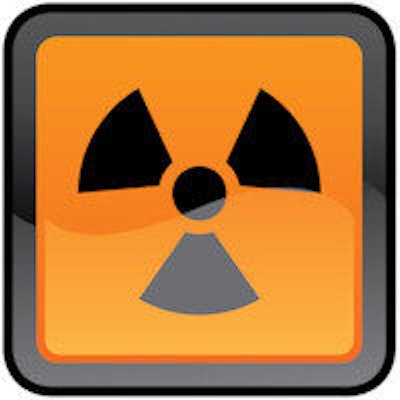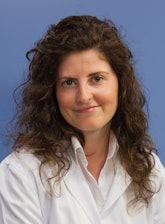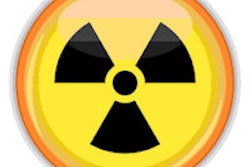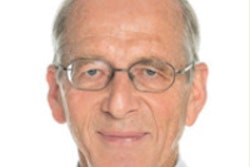
Patients injected with radiopharmaceuticals for nuclear medicine procedures continue to give off radiation after their scans are completed, and steps should be taken to reduce the public's exposure to these individuals until the radiopharmaceuticals decay, according to Spanish researchers.
 Lead author Dr. Verónica Morán Velasco from the Clínica Universidad de Navarra.
Lead author Dr. Verónica Morán Velasco from the Clínica Universidad de Navarra.The findings, published in the current issue of the Revista Española de Medicina Nuclear e Imagen Molecular, found that individuals who accompany a patient who has been injected with a radiopharmaceutical may be exposed to as much as 0.63 mSv of radiation.
The paper, by Dr. Verónica Morán Velasco from the Clínica Universidad de Navarra and colleagues from the Instituto de Investigación Sanitaria de Navarra, both in Pamplona, also suggests that physicians who regularly tend to nuclear medicine outpatients consider restricting the number of scans they oversee during the course of a year to also avoid unnecessary radiation exposure as well.
The recommendations are dependent, in large part, to the amount of dose administered, as long as the reduction in radiotracer does not adversely affect the quality of the diagnostic study (Rev Esp Med Nucl Imagen Mol, May-June 2016, Vol. 35:3, pp. 175-185).
Potential exposure
Several previous studies have explored the degree to which the public may be exposed to radiation from patients who have received a radiopharmaceutical as part of a nuclear medicine scan. However, there is limited information on how much radiation a person in a waiting room may be exposed to right after a patient's injection, or the potential cumulative effect that radiation may have on a physician who sees a patient right after his or her scan.
To try to calculate that effect, researchers prospectively studied 190 patients (124 women and 66 men) with a median age of 58 (range 11 to 93), median body mass of 69.5 kg (range 34 to 125 kg), and a median height of 164 cm (range 147 to 188 cm).
Subjects in the cohort were scheduled for a variety of scans, with the majority of patients (145 cases, 76%) undergoing bone scintigraphy with technetium-99m (Tc-99m).
The study estimated the radiation dose for each subject from the time the radiotracer was injected to the start of the imaging scan, as well as the total time spent in the nuclear medicine department. The latter included the length of the scan, time in the waiting room, and when the patient left the building.
Time, place scenarios
To gauge radiation exposure to people who may come in contact with a tracer-injected patient, researchers created several scenarios. The primary example is an individual such as a family member who accompanies the patient to the facility.
Researchers also crafted a situation where the patient spent 20 minutes in a physician's office at a distance of 1 m during the first five minutes, 0.5 m in the next 10 minutes, and 0.1 m during the final five minutes.
To compare the risk of radiation exposure inside and outside of the nuclear medicine department, the paper created two public scenarios. One case had the patient in a coffee shop for 30 minutes at a distance of 0.5 m to the nearest person and in a restaurant for 60 minutes at a distance of 0.5 m from his or her nearest neighbor.
If the patient were to use public transportation or leave the hospital in a private vehicle, it was assumed he or she would spend one hour riding at a distance of 1 m from the nearest passenger.
Exposure calculations
Using the above-mentioned time and distance parameters and applying laws related to the decay of radioactive contrast agents, researchers estimated that a person who accompanies a patient might receive up to 0.63 mSv for cardiac studies or 0.18 mSv for bone scintigraphy exams.
Meanwhile, the dose received by coworkers in the scenario of a patient who returned to work immediately after a scan was 82 µSv -- an amount that would be dramatically reduced if the patient did not return to work until the day after the exam. A physician may receive 23 µSv while in close proximity to the tracer-injected patient, compared with 43 µSv for a person at a restaurant, and 22 µSv for a nearby person in a coffee shop.
"After finishing the procedure, these doses are reduced by a factor of three," the authors wrote. "In most of the studies, the use of private instead of public transport may reduce the dose by more than a factor of six."
Of particular note is the finding that a person accompanying the patient to the scan may be subject to radiation similar to the dose received by the patient. Therefore, researchers recommended a greater distance between radiotracer-injected patients and others in the waiting room, based on the type of scan performed and amount of radiopharmaceutical injected.
In addition, they wrote it "may be necessary to limit the number of patients undergoing nuclear medicine diagnostic tests attended by physicians in their consulting offices."
And, once the scan is completed and the patient is set to leave the building, the paper recommends he or she use private rather than public transportation.
"These recommendations are dependent on the dose administered and thus a reduction in dose that does not affect the quality of the diagnostic study would allow a reduction in the dose to which individuals are exposed," the researchers concluded. "A reduction in the radiation dose would not only reduce the individual, but also the collective dose produced by the irradiation of members of the public by patients" undergoing nuclear medicine scans.



















